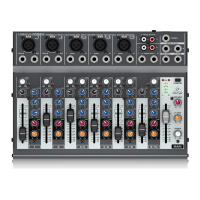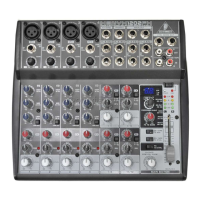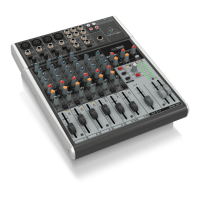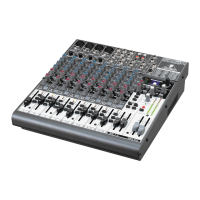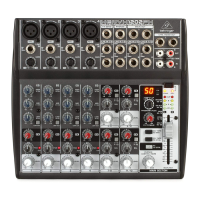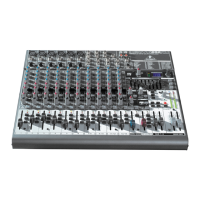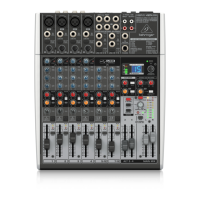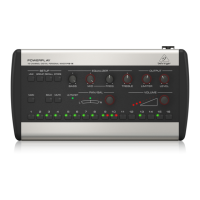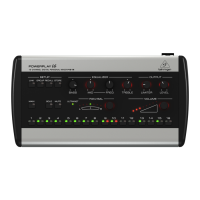XENYX 502/802/1002/1202
Control elements and connectors 5
can be found in the support area of our website (http://www.
behringer.com).
Registering your purchase and equipment with us helps us process
your repair claims more quickly and efciently.
Thank you for your cooperation!
Control elements and connectors2.
This chapter describes the various control elements of your mixing
console. All controls, switches and connectors will be discussed
in detail.
Mono channels2.1
Microphone and line inputs2.1.1
Connectors and controls of mic/line inputsFig. 2.1:
MIC
Each mono input channel offers a balanced microphone input via
the XLR connector and also features switchable +48 V phantom
power supply for condenser microphones. The XENYX preamps
provide undistorted and noise-free gain as is typically known only
from costly outboard preamps.
Please mute your playback system before you activate +
the phantom power supply to prevent switch-on thumps
being directed to your loudspeakers. Please also note
the instructions in chapter 2.3.5 “Phantom power and
LED displays”.
LINE IN
Each mono input also features a balanced line input on a 1/4"
connector. Unbalanced devices (mono jacks) can also be con-
nected to these inputs.
Please remember that you can only use either the mi- +
crophone or the line input of a channel at any one time.
You can never use both simultaneously!
TRIM
Use the TRIM control to adjust the input gain. This control should
always be turned fully counterclockwise whenever you connect
or disconnect a signal source to one of the inputs.
Equalizer2.1.2
All mono input channels include a 3-band equalizer, except for
the 502, which is equipped with a 2-band EQ. All bands provide
boost or cut of up to 15 dB. In the central position, the equalizer
is inactive.
The circuitry of the British EQs is based on the technology used
in the best-known top-of-the-line consoles and providing a warm
sound without any unwanted side effects. The result are extremely
musical equalizers which, unlike simple equalizers, cause no side
effects such as phase shifting or bandwidth limitation, even with
extreme gain settings of ±15 dB.
The equalizer of the mono input channelsFig. 2.2:
EQ
The upper (HI) and the lower band (LO) are shelving lters that
increase or decrease all frequencies above or below their cut-off
frequency. The cut-off frequencies of the upper and lower band are
12 kHz and 80 Hz respectively. The mid band (802/1002/1202) is
congured as a peak lter with a center frequency of 2.5 kHz.
LOW CUT
In addition, the mono channels (1002 and 1202) are equipped with
a steep LOW CUT lter (slope at 18 dB/oct., -3 dB at 75 Hz) de-
signed to eliminate unwanted low-frequency signal components.
FX sends, panorama and level adjustment2.1.3
The FX send/panorama/level controlsFig. 2.3:
FX (802/1002/1202 only)
FX sends (or AUX sends) enable you to feed signals via a variable
control from one or more channels and sum these signals to a
bus. The bus appears at the console’s FX send output and can
be fed from there to an external effects device. The return from
the effects unit is then brought back into the console on the aux
return connectors (802) or normal channel inputs. Each FX send
is mono and features up to +15 dB gain.
As the name suggests, the FX sends of the XENYX mixing con-
soles are intended to drive effects devices (reverb, delay, etc)
and are therefore congured post-fader. This means that the mix
between dry signal and effect remains at the level determined by
the channel’s aux send, irrespective of the channel fader setting.
If this were not the case, the effects signal of the channel would
remain audible even when the fader is lowered to zero.
PAN
The PAN control determines the position of the channel signal
within the stereo image. This control features a constant-power
characteristic, which means the signal is always maintained at a
constant level, irrespective of position in the stereo panorama.
LEVEL
The LEVEL control determines the level of the channel signal in
the main mix.
CLIP
The CLIP LED’s of the mono channels illuminate when the input
signal is driven too high, which could cause distortion. If this hap-
pens, use the TRIM control to reduce the preamp level until the
LED does not light anymore.

